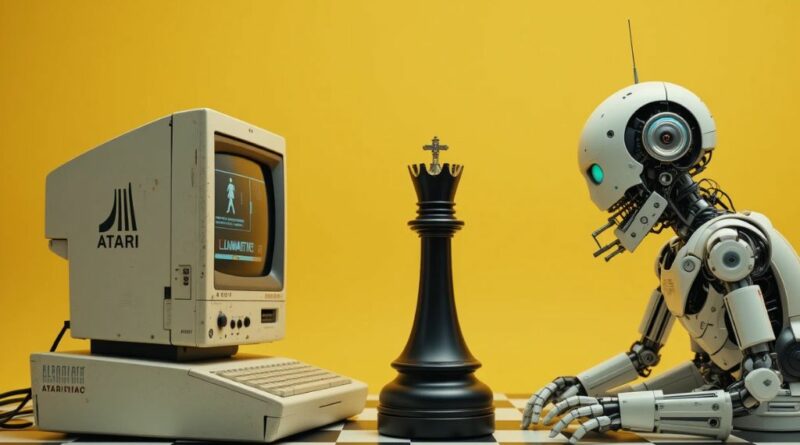The Day an Atari 2600 Humbled ChatGPT at Chess
How a 1970s gaming console exposed the surprising limitations of modern artificial intelligence
Artificial intelligence has for the most part brought us stories of technological wonder and triumph—generally surpassing human capabilities, algorithms solving complex problems, and AI systems achieving superhuman performance. Yet sometimes, the most illuminating tales come from unexpected defeats. Such was the case when OpenAI’s ChatGPT, one of the most sophisticated language models ever created, was soundly defeated by a humble Atari 2600 console from 1977.
The Unlikely David and Goliath Story
The revelation came through Robert Caruso, a Citrix software engineer who documented this fascinating encounter on LinkedIn. What started as a casual conversation about the history of AI in chess led to an impromptu match between ChatGPT and Atari Chess, a game released in 1979 for the Atari 2600 system. The results were, in Caruso’s words, an absolute thrashing of the modern AI by the vintage gaming system.
For an hour and a half, ChatGPT struggled against what should have been a trivial opponent. The chatbot repeatedly confused rooks with bishops, misread moves, and lost track of piece positions on the board. Most tellingly, it made what Caruso described as “enough blunders to get laughed out of a 3rd grade chess club,” all while insisting it would win “if we just started over.”
Meanwhile, the Atari 2600—with its modest 1.19MHz processor and 128 bytes of RAM—simply executed its programmed logic with 1970s efficiency. No neural networks, no vast training datasets, no computational bells and whistles. Just straightforward board evaluation and what Caruso aptly termed “1977 stubbornness.”
The Historical Context of Chess and AI
To understand the significance of this digital David versus Goliath story, one must appreciate chess’s pivotal role in artificial intelligence development. The game has served as a benchmark for machine intelligence since the earliest days of computing. In 1956—twenty-one years before the Atari 2600’s release—the MANIAC I computer at Los Alamos Scientific Laboratory became the first machine to defeat a human in a chess-like game, albeit on a simplified 6×6 board without bishops.
The lineage of chess-playing computers represents some of the most significant milestones in AI history. From Alex Bernstein’s program in 1957 to IBM’s Deep Blue defeating world champion Garry Kasparov in 1997, chess has consistently pushed the boundaries of what machines could achieve. Each advancement required dedicated hardware, specialised algorithms, and years of refinement.
The Atari Chess program, created by Larry Wagner and Bob Whitehead, was part of this evolutionary chain. Despite the console’s severe hardware limitations—less processing power than a modern calculator—the game implemented fundamental chess AI principles: position evaluation, limited move lookahead, and basic strategic understanding. It was designed to play competently within extremely tight constraints, a masterclass in efficient programming.
The Fundamental Difference in AI Approaches
The ChatGPT versus Atari Chess matchup illuminates a crucial distinction in artificial intelligence: the difference between specialised and generalised AI systems. The Atari 2600’s chess program was purpose-built for one task—playing chess. Every line of code, every algorithm, and every optimisation served this singular goal. It understood chess rules inherently, could evaluate positions mechanically, and executed moves with unwavering consistency.
ChatGPT, conversely, represents the pinnacle of generalised AI. It’s trained on vast amounts of text data to understand and generate human language across countless domains. While it possesses knowledge about chess rules, strategies, and famous games, this knowledge exists as text patterns rather than operational understanding. When asked to play chess, ChatGPT must translate between its language-based training and the spatial, rule-based nature of the game—a translation that evidently breaks down under pressure.
This distinction becomes even more stark when considering the recent trend in AI development. Modern large language models excel at appearing knowledgeable about virtually any topic, yet their performance can vary dramatically when moving from discussion to execution. They can write eloquently about chess strategy but struggle with the mechanical precision required for actual play.
The Broader Implications for Modern AI
The Atari versus ChatGPT chess match serves as a compelling case study in AI limitations that extend far beyond gaming. It highlights several critical points about our current technological moment:
The Illusion of Universal Competence: ChatGPT’s confident engagement with chess discussions might lead users to assume equivalent playing ability. This gap between conversational fluency and practical competence appears across many domains, from coding to mathematical reasoning to factual accuracy.
The Value of Specialisation: The Atari Chess program’s success demonstrates that focused, well-engineered solutions can outperform vastly more complex systems when the problem domain is clearly defined. This principle has profound implications for AI deployment in specific industries and applications.
The Importance of Representation: Chess requires spatial reasoning, rule adherence, and forward planning—cognitive processes that don’t translate seamlessly from language-based training. The mismatch suggests fundamental challenges in creating truly general artificial intelligence.
Recent Developments in AI Chess Performance
This isn’t an isolated incident of language models struggling with chess. Recent evaluations have consistently shown that while AI systems like ChatGPT can discuss chess strategy eloquently, their practical playing ability lags significantly behind dedicated chess engines. In tournament settings, specialised chess AI like Stockfish continues to dominate, analysing millions of positions per second with inhuman precision.
Interestingly, the gap isn’t merely about computational power. Even when given unlimited thinking time, large language models often make fundamental errors in chess that purpose-built programs would never commit. They might suggest illegal moves, ignore obvious tactics, or fail to recognise basic patterns that any dedicated chess algorithm would catch instantly.
The Human Element in AI Development
Perhaps most intriguingly, Caruso noted that ChatGPT referred to itself and the human player as “we” during the match, suggesting a collaborative rather than competitive framing. This linguistic choice reveals something profound about how these systems are designed to interact with humans—as assistants and partners rather than opponents or competitors.
This collaborative framing, while valuable for many applications, may actually hinder performance in competitive scenarios like chess. The Atari 2600, in contrast, was programmed with one goal: to win. This singular focus, combined with its specialised design, gave it a decisive advantage over the more diplomatically inclined ChatGPT.
Looking Forward: Lessons for AI Development
The Atari 2600’s unexpected victory offers valuable insights for the future of artificial intelligence development. As we rush towards increasingly general AI systems, we might be overlooking the elegant efficiency of specialised solutions. There’s something to be said for the focused competence of purpose-built tools versus the broad but sometimes shallow capabilities of generalist systems.
This doesn’t diminish the remarkable achievements of large language models like ChatGPT. Their ability to engage in sophisticated conversations, assist with complex tasks, and demonstrate understanding across vast domains represents a genuine breakthrough in AI. However, the chess incident serves as a healthy reminder that intelligence is multifaceted, and different types of problems may require different approaches.
The Enduring Appeal of the Underdog
Beyond its technical implications, the story of an Atari 2600 defeating ChatGPT resonates because it subverts our expectations about technological progress. We’re accustomed to newer always meaning better, to more complex systems inevitably outperforming simpler ones. Yet here was a console from the Carter administration, with processing power that wouldn’t impress a modern toaster, schooling one of the most advanced AI systems ever created.
There’s something delightfully human about celebrating this underdog victory. It reminds us that elegance, focus, and good engineering can triumph over sheer computational brawn. The Atari 2600’s chess program succeeded not despite its limitations, but because its designers worked creatively within them to create something genuinely effective.
Conclusion: The Wisdom of Knowing Your Strengths
The tale of ChatGPT’s chess humiliation by an Atari 2600 offers a masterclass in the importance of understanding both capabilities and limitations in artificial intelligence. While ChatGPT excels at tasks involving language, reasoning, and broad knowledge synthesis, chess requires a different kind of intelligence—one that the Atari 2600, in all its 8-bit glory, was specifically designed to provide.
As we continue advancing artificial intelligence, this story serves as both a humbling reminder and an inspiring example. It suggests that the path forward might not always lie in creating ever-more-general systems, but in understanding when specialised tools are the right choice for specific tasks. Sometimes, the most sophisticated solution is also the simplest one—a lesson that a 1977 gaming console taught a 2024 AI system in the most direct way possible: by winning.
The next time you see an old Atari 2600 at a car boot sale or in a museum, remember that this unassuming beige box represents more than just gaming history. It embodies a philosophy of focused engineering that, decades later, proved capable of teaching modern AI a valuable lesson about the difference between appearing intelligent and actually being effective.
After all, in the immortal words of the engineers who created these early systems: sometimes the best AI is the one that just does its job, no matter how humble that job might seem.
We’d love your questions or comments on today’s topic!
For more articles like this one, click here.
Thought for the day:
“We must be willing to let go of the life we have planned, so as to have the life that is waiting for us.”
E. M. Forster



